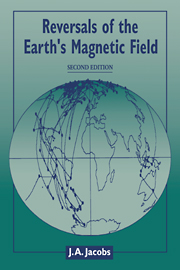Book contents
5 - Models for reversals
Published online by Cambridge University Press: 23 September 2009
Summary
Introduction
Theories on the cause of reversals of the Earth's magnetic field fall into one of two general classes. First there are those which maintain that reversals result from magnetic hydrodynamic instabilities, triggered by finite-amplitude perturbations of an otherwise stable dynamo. The perturbations are usually assumed to have their origin within the core, such as instabilities in the pattern of convective flow (Cox, 1968; Parker, 1969; Levy, 1972a–c; Olson, 1983). An external origin has been suggested (e.g. Muller and Morris, 1986), although, as discussed later, this seems unlikely. This class of dynamos is considered in Section 5.2. The second class of theories maintains that reversals are the result of irregular oscillations of a non-linear a.c. dynamo (e.g. homopolar disc dynamos – Rikitake, 1958; Robbins, 1977). Such dynamos are considered in Section 5.3. They are intrinsically oscillatory and, unlike models in the first category, perturbations are not required to initiate a reversal. Most linear a.c. kinematic dynamos have sinusoidal behaviour in time, although the Earth's field does not. The palaeomagnetic field has long periods of one polarity, in which the field intensity fluctuates about an average value, separated by relatively brief transitions. The Earth's field reverses its polarity at irregular intervals, the average time between reversals at present being a few hundred thousand years. This is much shorter than the timescales of mantle convection and plate tectonic processes (∼108 a), but much longer than the timescale for the free decay of electrical currents in the OC (∼1.5 × 104 a). There are no known dynamical processes in the Earth's deep interior which operate on the reversal timescale.
Information
- Type
- Chapter
- Information
- Reversals of the Earth's Magnetic Field , pp. 124 - 178Publisher: Cambridge University PressPrint publication year: 1994
